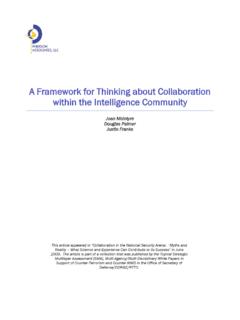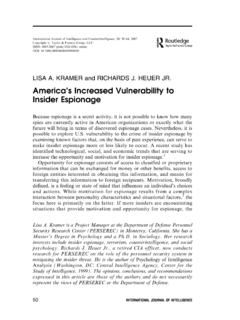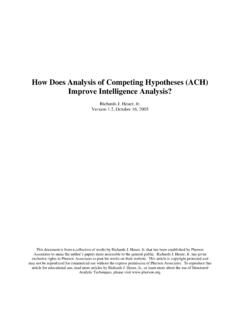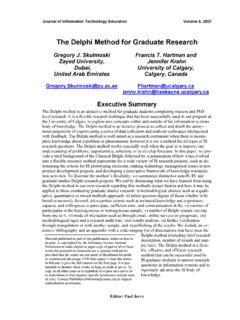Transcription of Taxonomy of Structured Analytic Techniques - …
1 Copyright 2008 Richards J. Heuer, Jr. and Pherson Associates, LLC 1 Taxonomy of Structured Analytic Techniques by Richards J. Heuer, Jr. This paper was prepared for the International Studies Association 2008 Annual Convention March 26 29, 2008 San Francisco, CA research was funded by Least Squares Software in support of IARPA contract FA8750-07-C-0132 on Multimethod Sensemaking Copyright 2008, Richards J. Heuer, Jr. Approved for unlimited US Government use. This document is from a collection of works by Richards J. Heuer, Jr. that has been established by Pherson Associates to make the author s papers more accessible to the general public. Richards J. Heuer, Jr. has given exclusive rights to Pherson Associates to post his works on their website. This article is copyright protected and may not be reproduced for commercial use without the express permission of Pherson Associates.
2 To reproduce this article for educational use, read more articles by Richards J. Heuer, Jr., or learn more about the use of Structured Analytic Techniques , please visit Copyright 2008 Richards J. Heuer, Jr. and Pherson Associates, LLC 2 Taxonomy of Structured Analytic Techniques by Richards J. Heuer, Jr. Abstract: This paper is the first part of a broader project to define and further develop the domain of what are now called Structured Analytic Techniques for intelligence analysis. It distinguishes these Techniques from three other broad categories of intelligence analysis methods and then presents a Taxonomy of the Structured Techniques . The Structured Techniques are categorized by how they help analysts overcome one or more of the well-known human cognitive limitations or pitfalls that often inhibit effective analysis.
3 It describes five categories of Structured Analytic Techniques : decomposition and visualization; indicators, signposts, and scenarios; challenging mindsets; hypothesis generation and testing; and group process Techniques . I am best known for my book, Psychology of Intelligence Analysis, which describes the cognitive limitations and pitfalls typically encountered by intelligence analysts and has been used for many years now in training new analysts throughout the Intelligence Many readers of my book are discouraged to learn of the extent of our cognitive limitations and the multitude of pitfalls encountered when intelligence analysts must cope with incomplete, ambiguous, and often deceptive information. As one reader told me, it makes you wonder if it is possible to ever get anything right.
4 There is, of course, no magic formula for always making the right Analytic judgment. There are, however, well-established procedures for reducing the frequency and severity of error. These are what the Intelligence Community now calls Structured Analytic Techniques , or SATs for short, and this is the area I m working on now. Those of you familiar with the various Commission reports on reforming intelligence analysis will be familiar with the recommendations to conduct more alternative analysis. That term is no longer being used, because it came to be thought of as something one does occasionally as an alternative to traditional analysis. We now think those tools and other similar Techniques should be used regularly and normally as best practices, and this is what are now called Structured Analytic Techniques .
5 1 Richards J. Heuer, Jr., Psychology of Intelligence Analysis (Washington, DC: CIA Center for the Study of Intelligence, 1999). Copyright 2008 Richards J. Heuer, Jr. and Pherson Associates, LLC 3 With financial support from the ODNI Intelligence Advanced research Projects Activity (IARPA), I have been working with Least Squares Software on a multifaceted project to define and help further develop the domain of Structured Analytic Techniques . What I will talk about today is a Taxonomy that defines the domain of Structured Techniques , how they relate to other methods used in intelligence analysis, and how they contribute to providing a better Analytic product. A Taxonomy is a classification of all the elements of some domain of information or knowledge.
6 It defines a domain by identifying, naming, and categorizing all the various element in that domain. The elements are organized into related groups based on some factor that is common to each element in the group. Let s look first at four general categories of methods used for intelligence analysis to see where Structured Analytic Techniques fit into this overall picture. Quantitative methods using empirical data: For intelligence analysis, the empirical data we work with may be collected by some type of sensor and used, for example, in analysis of a weapons system. Econometric modeling is another common example of this method. Training in such methods is generally obtained through graduate education in economics or the hard sciences. Quantitative methods using expert-generated data: We don t have empirical data for many of the things we have to analyze.
7 In the absence of empirical data, many methods are designed to use quantitative data generated by expert opinion or judgment. Special procedures are used to elicit subject matter experts quantitative judgments. This includes many decision analysis methods, Bayesian inference projects, dynamic modeling, and simulation. Training for this type analysis is provided through graduate education in fields such as information science, operations research , business, or the hard sciences. Copyright 2008 Richards J. Heuer, Jr. and Pherson Associates, LLC 4 Unaided judgment:2 This is how most strategic and political analysis is now being done. It includes evidentiary reasoning, the basics of critical thinking, historical method, case study method, and reasoning by One very distinctive characteristic of unaided judgment is that it is usually an individual effort in which the thinking remains largely in the mind of the individual analyst until it is written down in a draft report.
8 Training in this type of analysis is generally provided through graduate education, especially in the social sciences and liberal arts. Structured analysis: This uses Structured Techniques to mitigate the adverse impact on our analysis of known cognitive limitations and pitfalls. The most distinctive characteristic is that Structured Techniques externalize and decompose our thinking in a manner that enables it to be reviewed and critiqued piece by piece, or step by step, by other knowledgeable analysts. These Techniques can be used by the average analyst who lacks advanced training in statistics, math, or the hard sciences. For most analysts, training in Structured Analytic Techniques is obtained only within the Intelligence Community. That shows where Structured Techniques fit into the overall spectrum of methods used in intelligence analysis.
9 Now we look at the Structured Techniques in greater detail and categorize them by how they help analysts overcome one or more of the well-known human cognitive limitations or pitfalls that inhibit effective analysis. Decomposition and Visualization: The number of things most people can keep in working memory at one time is seven, plus or minus Complexity increases geometrically as the number of variables increases. In other words, 2 This is often referred to as traditional analysis. It is also called intuitive analysis, but I do not like that term. The American Heritage online dictionary definition of intuition is the act or faculty of knowing or sensing without the use of rational processes. Unaided judgment often involves very careful and systematic reasoning.
10 3 Reasoning by analogy can also be a Structured technique . See Kesten C. Green and J. Scott Armstrong, " Structured Analogies for Forecasting" (Monash University Econometrics and Business Statistics Working Paper No. 17/04 (2004). Available at SSRN: 4 George A. Miller, The Magical Number Seven, Plus or Minus Two: Some Limits on Our Capacity for Processing Information, The Psychological Review, Vol. 63, No. 2 (March 1956). Copyright 2008 Richards J. Heuer, Jr. and Pherson Associates, LLC 5 it is very difficult to do error-free analysis only in our heads. The two basic tools for coping with complexity in analysis are: (1) break things down into their component parts, so that we can deal with each part separately, and (2) put all the parts down on paper or a computer screen in some organized manner such as a list, matrix, map, or tree so that we and others can see how they interrelate as we work with them.)







